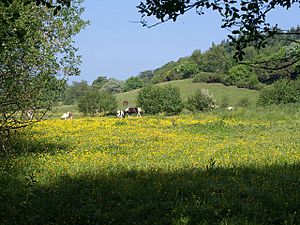Roebuck Meadows facts for kids
| Site of Special Scientific Interest | |
 |
|
| Area of Search | Somerset |
|---|---|
| Coordinates | 51°06′41″N 3°14′29″W / 51.11130°N 3.24133°W |
| Interest | Biological |
| Area | 3.6 hectares (0.036 km2; 0.014 sq mi) |
| Notification | 1988 |
Roebuck Meadows is a special natural area in Somerset, England. It covers about 3.6 hectares (which is about 9 football fields!). This place was officially recognized in 1988 as a Site of Special Scientific Interest (SSSI). This means it's a very important spot for nature and wildlife in the United Kingdom.
Contents
What Makes Roebuck Meadows Special?
Roebuck Meadows is a unique place because it has a mix of different types of land. It includes areas of wet, boggy ground called lowland mire and also rich grassland. These different habitats work together to create a home for many interesting plants.
A Rare Habitat: Lowland Mire
Lowland mire is a type of wetland that is quite rare in the UK. It's like a bog or a marsh, but it's found in lower areas, not just on mountains. This kind of habitat is super important because it supports plants and animals that can't live anywhere else. The soil is often wet and has special nutrients that only certain plants like.
Amazing Plants of the Meadows
The meadows are full of different kinds of plants, especially herbs. One of the most exciting plants you can find here is called Cornish moneywort (Sibthorpia europaea). This plant is very special because it's nationally scarce, meaning there aren't many of them left in the country. You can mostly find it in the south-west part of Britain. Its presence makes Roebuck Meadows even more valuable for conservation.
Why Protect Roebuck Meadows?
Protecting places like Roebuck Meadows is really important for a few reasons:
- Biodiversity: It helps keep a wide variety of plants and animals alive.
- Rare Species: It provides a safe home for rare plants like the Cornish moneywort.
- Natural Heritage: It preserves unique natural landscapes for future generations to enjoy and learn from.
By keeping these areas safe, we make sure that special habitats and the creatures that live in them can continue to thrive.

